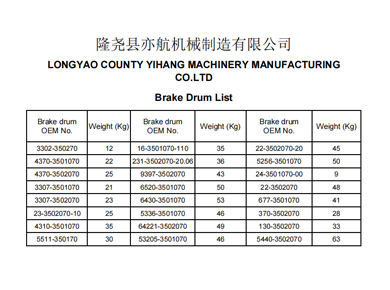Aug . 20, 2024 03:27 Back to list
Measuring Brake Drum Thickness with Precision Tools for Optimal Performance
Understanding Brake Drum Gauge Ensuring Safety and Performance in Vehicles
Brake systems are critical components in every vehicle, ensuring safety and reliability during operation. One essential tool for maintaining effective braking performance is the brake drum gauge. This instrument plays a pivotal role in the evaluation and maintenance of brake drums, which are integral to the drum brake system typically found in many vehicles.
What is a Brake Drum Gauge?
A brake drum gauge is a specialized measuring tool used to assess the internal diameter of brake drums. This gauge helps determine whether the brake drum is still within safe operational limits or if it requires replacement or machining. The gauge typically consists of calibrated markings that allow mechanics to take accurate measurements of the drum's internal diameter, which is critical for ensuring optimal braking performance.
Brake drums, over time, can wear down due to friction and heat generated during braking. This wear can lead to an increase in the drum's diameter, which impacts the performance of the brake shoes. If the brake drum exceeds its maximum allowable diameter, it can cause a range of problems including decreased braking efficiency, poor pedal feel, and increased stopping distances, posing a significant safety risk.
Why is Regular Measurement Important?
Regular measurement of brake drums is vital for several reasons. Firstly, it ensures that the brake system functions effectively. A drum that has exceeded its specifications can lead to brake fade, where there is a reduction in stopping power due to overheating. In extreme cases, this can result in brake failure, endangering the lives of both the vehicle occupants and others on the road.
Secondly, using a brake drum gauge can help identify uneven wear. Unevenly worn drums can cause vibrations and noise during braking, leading to further issues with the overall vehicle performance. By detecting these irregularities early, mechanics can take corrective actions such as resurfacing the drum or replacing it altogether, thus preventing more significant mechanical failures and increasing the lifespan of the brake components.
How to Use a Brake Drum Gauge
brake drum gauge

Using a brake drum gauge is straightforward, but it does require a careful approach for accuracy. Here are the basic steps
1. Preparation Ensure that the vehicle is securely lifted and supported on jacks to allow safe access to the wheels.
2. Removing the Wheel Take off the corresponding wheel to access the brake drum.
3. Measuring Insert the brake drum gauge into the drum’s internal area. Rotate it to ensure that it makes contact with the drum’s surface. Read the measurement at the widest point of the drum.
4. Comparison Compare the measured diameter to the manufacturer’s specifications for that drum. If the measurement exceeds the specified limit, the drum should be either replaced or resurfaced.
5. Repeat as Necessary It’s advisable to check multiple points around the drum to ensure consistent measurements.
Conclusion
In conclusion, the brake drum gauge is an invaluable tool for mechanics and vehicle enthusiasts alike. Regularly measuring brake drums not only enhances safety but also contributes to the overall performance of a vehicle. By ensuring that the brake system remains within specifications, drivers can enjoy peace of mind knowing that their vehicles are equipped to stop effectively when needed. Investing time in understanding and utilizing tools like the brake drum gauge can lead to significant benefits, ultimately keeping roads safer for everyone.
-
Brake Drum Man - High-Quality Drum Brake Drums & Brake Shoes for Reliable Performance
NewsJun.24,2025
-
High-Quality Brake Drum Kamaz – Durable Drum Brake Drum & Brake Shoe Replacement
NewsJun.10,2025
-
High-Quality Brake Drum Liza for Drum Brake Systems - Superior Durability and Performance
NewsJun.10,2025
-
High-Quality Brake Drum Kamaz – Durable Drum Brake Drum & Brake Shoe Solutions
NewsJun.10,2025
-
Durable Kamaz Brake Drums High-Performance Truck Parts
NewsJun.09,2025
-
Premium Brake Drum Maz Kit with Shoes Enhanced Braking
NewsJun.09,2025
